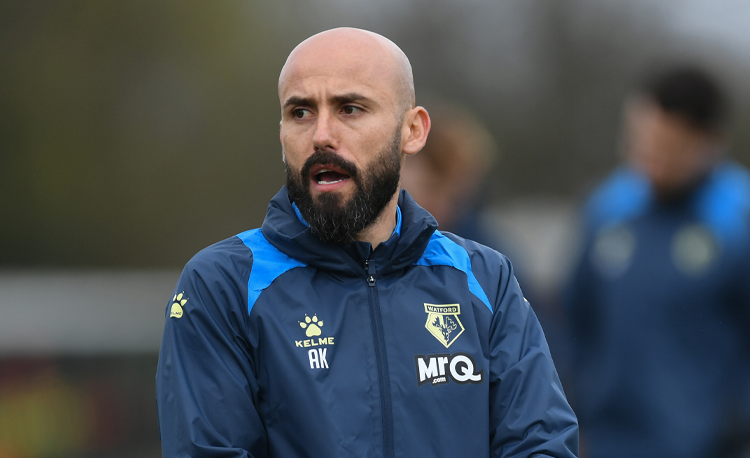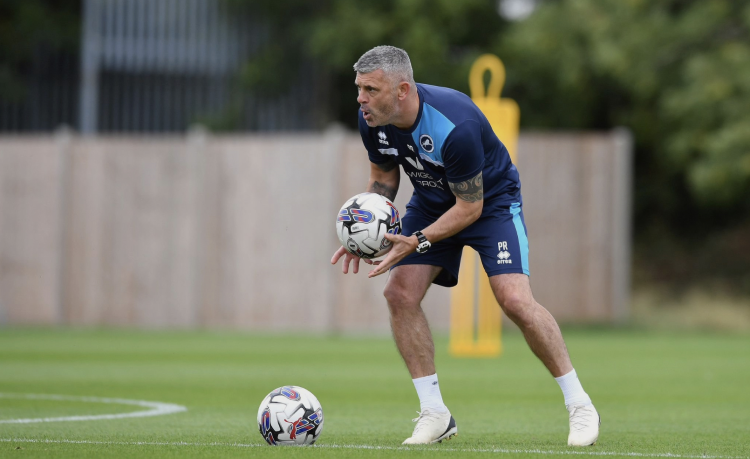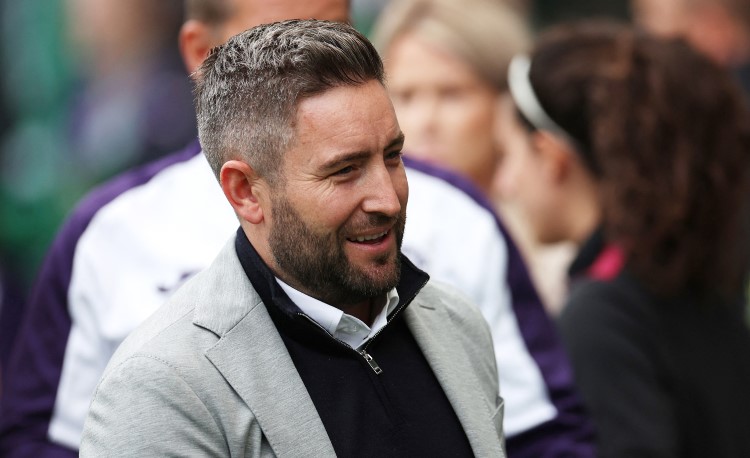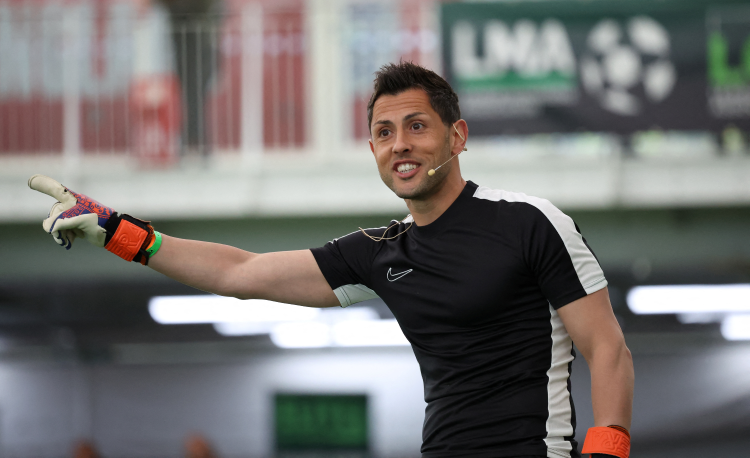Sunflower positioning
The focus of this session is looking at the full-back - in this instance, the left-back’s - body position.

| Area | Up to two thirds of full size pitch |
| Equipment | Balls, bibs, full size goal, x4 mini goals |
| No. of Players | Up to 10 outfield + 2 goalkeepers |
| Session Time |
Positioning: 20-25mins |
I’ve noted too many instances of goals scored when the left-back is more concerned with the player behind them, the right-sided attacking player (number 7), while failing to react to the centre-forward peeling off the centre-back in the inside-right channel to find the back of the net.
Indeed, I’ve learnt the hard way of playing full-back during my playing career: balls being played inside of me while I, as the left-back, was more focused on the right-winger. While I was doing that, my body shape was facing out to the winger, and balls would be played inside of me to which I’d struggle to react, and the winger would either make movements, come short, or run in behind me.
So the focus of the session is looking at how we can counter this issue, and thus we’re looking at the full-back - in this instance, the left-back’s - body position.
It will help you not concede goals, to win the ball back, be in a better position and eliminate the opposition from playing balls inside you.
I like to run this session once a week, to keep planting the seed. This is important not only for the full-backs and centre-backs but for your wingers. Sometimes you’re winning by a goal late on, and the left or right winger may need to step back into a back five. In these situations, they need to have knowledge of playing in the full-back position. They need to be taught in terms of the body position, and in anticipating late runs from the full-back and the midfielder. So the need to have the right body position and an awareness, in terms of what’s around them, and the view of what’s coming at them, is important.
It also depends on the type of team you’re going to come up against. If they’ve got wingers and midfielders looking to get in behind, you have to prepare properly - showing video of the opposition before the session - before going out and practicing for maybe 20-25 minutes.
Sunflowers always follow the sun in the sky, they always follow where the sun is, and that’s the idea - sunflower position means always following the ball, and by doing so you can also see the player on the outside, looking to turn inside.
For example, put yourself in the left-back position; the ball is in the inside-right area, the ball comes back to the midfielder, the right-winger is on the outside of the left-back and they’re about to switch play. I want my left-back to be facing inside so they can see the two centre-backs and right-back, the midfielders in front and at the same time controlling where the right-winger is, a couple of yards behind, who they can see out of the corner of their eye.
That split second as you turn and lose sight of the ball, you can be in trouble. So always follow the ball, you can see the player - the right-winger on the outside - and the player about to kick the ball. So you’re moving your feet, rather than turning inside and trying to go and meet the ball or close the right-winger down the other way, which means for one split second you lose sight of the ball.
I always want my players to see the ball. Of course, in another situation, the ball gets played quickly inside and you have to turn inside, that can happen - but if you’re in a good position you can normally see the player kicking the ball, and the right-winger receiving the ball, and as soon as this happens, the purpose is to close down as quickly as possible, with side-on body shape. So if they try and play a one-two inside you’re already in a position to turn and you have an advantage.
If you look at the back four as a whole, the body shape of the full-backs should be facing inside. So the left-back, if they look across the line, they can see where their fellow three defenders are - the two centre-backs and right-back. From the opposing flank, the right-back has the same view across the back-line, including seeing where the left-back is [1].

So I want the back four almost facing each other, the main purpose of which is that you’re almost telling the opposition - and whoever is on the ball - that you’re dictating where you want the ball to be played, by facing inside when defending.
If you put yourself in the left-back position, you have a view of the whole of the pitch, as well as out of the corner of your eye. You can control everything in this situation - the person who’s on the ball, you can see the line of your defenders - the two centre-backs and right back - and you can see the right-winger. Whereas, if you were just facing towards the right-winger, you can’t really see what’s happening behind you, in relation to your other defenders - for example, whether your centre-backs are looking to step up. By facing the other way - inside - you have a better view and you control everything.
So that’s the main purpose of the session, concentrating on body shape of the full-backs and the centre-backs, of controlling and having a better view of the game - and thus improving the communication between them.
There is also the consideration of reacting when the attacking central midfielder (number 6) is making a pass. Normally players, when they receive the ball, take two or three touches before they make this pass - this is the trigger point for the defenders in terms of starting to move back and sideways, aware, preparing for the potential pass over the top, so you start to anticipate before.
You can also control the run of the right-winger; if they start to come across you, you can control them by blocking using your body. If they try to run in behind you’re already a couple of yards ahead of them to intercept.
Where’s the danger for the team defending? The danger is central, which is not where they want the play to be, they want the opposition team to play on the outside so they can deal with that better. The exercise is to avoid those inside passes through the channels.
POSITIONING
We set up on a half pitch, with a full size goal with a goalkeeper in at one end, and a goalkeeper at the other end. Two teams play 5v5 in the area.
The focus is for the left-back to concentrate, to sense danger, and in doing so be positioned more on the inside rather than outside.
In this scenario, as the reds set about transferring the ball from the left to the right, the defensive line should be positioned side-on, aware of any danger around them, as well as anticipating the ball being played to their opposite attacking number.
The left-winger (number 11) plays the ball back inside to the number 10, who transfers the ball out to the right-winger (number 7).
The defensive quartet shuffle across the pitch towards the danger. The central midfielder (number 8) plays the ball out wide to the right-winger, looking to play a one-two, running into the space behind the left-back in the outside right channel. However, notice how the side-on position of the left-back means that there is more chance of this danger being anticipated and the one-two option being blocked or cut off, which will allow the defender to turn quicker and win the ball [2a].
[2a]

- The ball is transferred from left to right via the left-winger and central midfielder
- The back four are positioned side-on inside, able to react quickly to the ball being transferred from one wing to the other
- The back four move across towards the player in possession
- The number 8 plays the ball wide to the number 7, looking to play a one-two, running into the space behind the left-back
- The side-on position of the left-back means there is more chance of this danger being intercepted
In another example, the number 10 works the ball across to the number 8, in the inside-right channel, looking to play in the right-winger (number 7) on the outside, inside the left-back. Again, the side-on position of the defenders, the left centre-back and particularly the left-back - mean that the attacking danger can better be anticipated by seeing more of the pitch, and thus preventing the inside pass option, or anticipating the pass quicker, by being on the front foot, and thus preventing a scoring opportunity [2b].
[2b]

-
The number 10 works the ball across to the number 8, looking to play in the number 7, inside the left-back
- The side-on position of the defenders means that the attacking danger can be anticipated quickly
Another consideration in wanting the full-backs facing inside is so that they can see the centre-backs stepping up, and step up with them.
The goalkeeper begins the move, making an additional player in starting the attack near the halfway line. They play the ball out to the left to the number 6, who has passing options in the form of the left-winger moving wide; the number 10 progressing in the centre-forward position; or the right-winger (number 7), looking to find space coming in from wide into the inside right channel. Notice the defenders facing side-on towards the ball, able to see more of the pitch and taking into account the options open to the passer – and able to anticipate the potential danger.
When the right centre-back moves out of the backline to press the centre-forward, the left centre-back, right-back and left-back must be narrow and body shape side, ready for any balls that may be played in behind into the space vacated [2c].
[2c]

-
The goalkeeper plays the ball out to the left to the number 6, who has passing options left, centre and right
- The defenders all facing the number 6 side-on (towards the ball), able to see more of the pitch and thus anticipate any potential danger
- The ball is played into the centre-forward, with the right centre-half moving out of the defensive shape to challenge
- The right-back, left centre-half and left-back must anticipate the danger in behind, and look to go narrow
- A quick lay-off from the centre-forward to the left-winger in this instance can pose danger, with the right-centre-half caught out of position and potential vacant space in behind - if the other defenders fail to react
“Notice the defenders facing side-on towards the ball, able to see more of the pitch and taking into account the options open to the passer”
PROGRESSION
We set up using two thirds of a full pitch, with a full-size goal and goalkeeper at the end using the penalty area, and a goalkeeper floating at the other end, with four mini goals set-up evenly across the width of the pitch.
The reds start with the ball and look to attack. The blues look to win the ball back, and are encouraged to use the techniques we worked on in the first part of the session. If the blues win the ball back, they must cross the halfway line and score in a mini goal.
In the example, the blues’ right-back and centre-backs are positioned side-on towards the left-back in the sunflower position. The left-back’s starting position also follows this shape as a starting trigger point once the number 6 takes possession. The left-back is able to anticipate and close the space in the channel - and intercepts, now helping lead the blues’ break out.
The left-back finds their team-mate in an advanced position, who must cross the halfway line before being allowed to shoot - and score - in one of the four mini goals [3].
[3]

- Play starts with the goalkeeper
- The reds look to build, working the ball to the right-winger
- The blues’ left-back steals the ball and they counter-attack, scoring in a mini goal
COACHING POINTS
What are the typical mistakes players might make and how do I avoid them?
As I’m working with the back four - two centre-backs and full-backs - as soon as the opposition midfielder gets the ball, or another player, and they know that the ball is going to go out wide to the winger, the full-back is defending, ready, their body shape already facing the winger depending on which side, and their back is turned towards their centre-backs and the other full-back, so they can’t really see what is going on behind. The player on the ball hasn’t made a decision to pass, but is already facing, and while doing that the right-winger is already facing and controlling the left-back - not even watching the ball, following the player rather than the ball.
By correcting positioning, side-on, facing inside, you control the situation, you control the timing of the trigger point when the midfielder receives. You can see the movement of the right-winger if they come short, you know what they’re trying to do. You want them to receive to feet so you can close down – the problem starts when they go short, you try to anticipate and they do another movement and spins in behind, that’s the ball we try to avoid, which is why we’re side-on.
Also important: the ball is on the right, the left-back is more concerned about the right-winger, but the centre-forward peels off the shoulder of the left centre-back, but the left-back is still focused on the winger - leaving the centre-back isolated 1v1 to a ball over the top. In this situation I encourage the left-back to be aware of the danger inside, ensuring they understand the need to protect the centre-back, recognising the danger inside, that they should protect - be ready in case the centre-back falls or slips, they should be aware of the need to cover.
Once the centre-back jumps out, leaving the other three defenders, they need to be aware of the threat behind, looking to go side-on and go narrower collectively. If there’s a flick round the corner, some quick, good play from the opposition, you need to be ready and aware of balls being threaded through, final passes and being side-on - which is where being more aggressive in terms of blocking people, staying with runners and recognising the danger of balls being played through the middle, which is not what we want - we want the ball out wide, we can deal with that, sprint out and close that. Anything through the middle, block, be aggressive, do everything to prevent this.
“By correcting positioning, side-on, facing inside, you control the situation, you control the timing of the trigger point when the midfielder receives. You can see the movement of the right-winger if they come short, you know what they’re trying to do. You want them to receive to feet so you can close down – the problem starts when they go short, you try to anticipate and they do another movement and spins in behind, that’s the ball we try to avoid, which is why we’re side-on”
Editor's Picks
Attacking transitions
Deep runs in the final third
Using the goalkeeper in build-up play
Intensive boxes drill with goals
Penetrating the final third
Creating and finishing
My philosophy
Pressing initiation
Compact team movement
Coaches' Testimonials

Alan Pardew

Arsène Wenger

Brendan Rodgers

Carlos Carvalhal

José Mourinho

Jürgen Klopp

Pep Guardiola

Roy Hodgson

Sir Alex Ferguson

Steven Gerrard
Related
Desire to defend at all costs
Crossing, finishing and defending
Flow the risk
Coaches' Testimonials

Gerald Kearney, Downtown Las Vegas Soccer Club

Paul Butler, Florida, USA

Rick Shields, Springboro, USA

Tony Green, Pierrefonds Titans, Quebec, Canada
Join the world's leading coaches and managers and discover for yourself one of the best kept secrets in coaching. No other training tool on the planet is written or read by the calibre of names you’ll find in Elite Soccer.
In a recent survey 92% of subscribers said Elite Soccer makes them more confident, 89% said it makes them a more effective coach and 91% said it makes them more inspired.
Get Monthly Inspiration
All the latest techniques and approaches
Since 2010 Elite Soccer has given subscribers exclusive insight into the training ground practices of the world’s best coaches. Published in partnership with the League Managers Association we have unparalleled access to the leading lights in the English leagues, as well as a host of international managers.
Elite Soccer exclusively features sessions written by the coaches themselves. There are no observed sessions and no sessions “in the style of”, just first-hand advice delivered direct to you from the coach.








